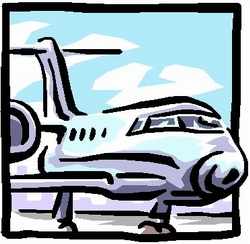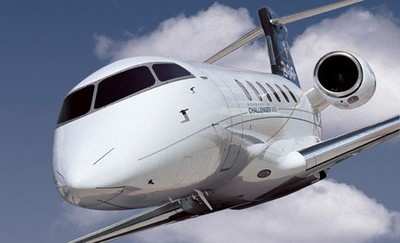Requires Implementation Of "Approved" Programs
 The days of relatively unfettered
travel onboard large business aircraft may soon come to an abrupt
end. Thursday morning, the Transportation Security Administration
(TSA) unveiled its proposed rule that will govern operations for
all aircraft weighing more than 12,500 pounds, which would require
those operators to implement an approved security program.
The days of relatively unfettered
travel onboard large business aircraft may soon come to an abrupt
end. Thursday morning, the Transportation Security Administration
(TSA) unveiled its proposed rule that will govern operations for
all aircraft weighing more than 12,500 pounds, which would require
those operators to implement an approved security program.
The proposed security rules, titled the "Large Aircraft Security
Program," would impose security programs on thousands of
privately-operated general aviation aircraft and ultimately seek to
combine a number of security programs currently in place for
general aviation, including the Twelve-Five Standard Security
Program, into a single, uniform program.
The National Air Transport Association provides the following
background:
In November 2007, US Department of
Homeland Security (DHS) Secretary Michael Chertoff introduced the
Large Aircraft Security Program (LASP) at NATA's Aviation Business
Roundtable in Washington, DC. Prior public comments by TSA
officials, as well as information provided by the White House
Office of Management and Budget (OMB), explained that the new
security program will require operators of aircraft with a maximum
certificated takeoff weight of more than 12,500 pounds to obtain
and implement the TSA's Large Aircraft Security Program. This is
the same category of aircraft that today must comply with the
Twelve-Five Standard Security Program if used in air charter
operations. The proposed rule, if adopted, will apply to privately
operated aircraft.
Late last week, the OMB gave its
approval for the TSA to publish the proposed rule for public review
and comment. In a conference call this morning, TSA officials
briefed NATA and other industry groups on the proposal, and the
agency has posted a copy of the notice of proposed rulemaking
(NPRM) on their Web site for early review prior to publication in
the Federal Register.

The NPRM -- available
here, and at the first FMI link below -- is
the result of a sweeping review of private aircraft operations by
DHS, and its TSA underlings.
As ANN reported earlier this year, Chertoff
strongly hinted DHS planned to issue requirements for crews and
passengers of private jets to provide their names, birthdates and
other information an hour before takeoff, so they can be checked
against terrorist watch lists.
 And that's exactly what's in the
NPRM. The proposed rule seeks to require, among other things,
flight crewmember criminal history records checks and security
threat assessments; watch list matching of passenger manifests; and
security training for all flight crew members. Operators would also
be required to have "Security Coordinators" on-staff.
And that's exactly what's in the
NPRM. The proposed rule seeks to require, among other things,
flight crewmember criminal history records checks and security
threat assessments; watch list matching of passenger manifests; and
security training for all flight crew members. Operators would also
be required to have "Security Coordinators" on-staff.
Still another requirement would be for designated reliever
airports -- airports that function to ease traffic at larger
commercial facilities, primarily by attracting corporate air
traffic -- to comply with new security requirements.
Further security measures for large aircraft operators in
all-cargo operations, and for operators of passenger aircraft with
a MTOW of over 100,309.3 lbs (45,500 kg), operated for compensation
or hire.
The NPRM carries a 60-day comment period.
Early reaction to the NPRM falls down predictable party lines...
with NATA President James Coyne largely applauding the proposed
guidelines.
"We have been eagerly awaiting the release of the Large
Aircraft Security Program for some time," Coyne said. "We are
currently reviewing the content of this new, ground-breaking
security measure, and we look forward to continuing our work with
DHS and TSA officials to ensure that the LASP's makeup
appropriately addresses legitimate security concerns while
recognizing the unique operating tendencies of the general aviation
industry."

Conversely, the 415,000-member Aircraft Owners and Pilots
Association expressed concern NPRM announced could have serious
implications on general aviation. "This proposed rule is an
unprecedented imposition of security requirements on the General
Aviation community affecting 10,000 individual operators and
hundreds of airports," said Andy Cebula, AOPA Executive Vice
President of Government Affairs. "An overwhelming majority of our
members surveyed last week expressed strong concerns about the
proposal."
AOPA notes its members questioned the limits on personnel
freedom, financial impacts and potential implications of the rule
for the broader general aviation community, seeing this as a start
for the Federal Government to regulate all non-commercial
operations.
"Our members believe that this proposal presents a potential
drain on our Nation’s limited financial resources for
aviation safety and security that could be better spent improving
other areas of our critical infrastructure," Cebula added.
 Aero-News: Quote of the Day (04.28.25)
Aero-News: Quote of the Day (04.28.25) ANN's Daily Aero-Term (04.28.25): Decision Altitude (DA)
ANN's Daily Aero-Term (04.28.25): Decision Altitude (DA) ANN's Daily Aero-Linx (04.28.25)
ANN's Daily Aero-Linx (04.28.25) Airborne-Flight Training 04.24.25: GA Refocused, Seminole/Epic, WestJet v TFWP
Airborne-Flight Training 04.24.25: GA Refocused, Seminole/Epic, WestJet v TFWP Aero-News: Quote of the Day (04.29.25)
Aero-News: Quote of the Day (04.29.25)






